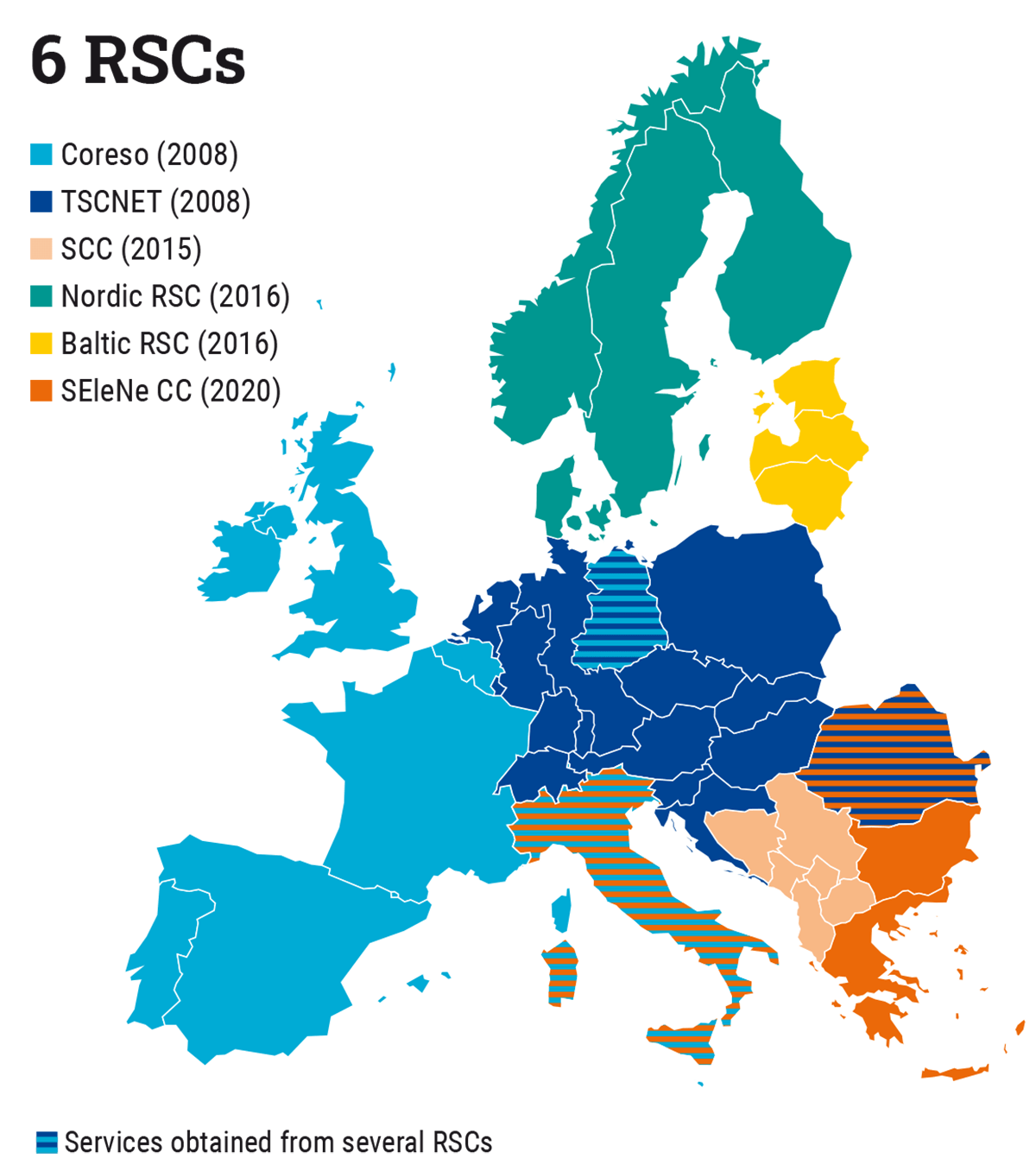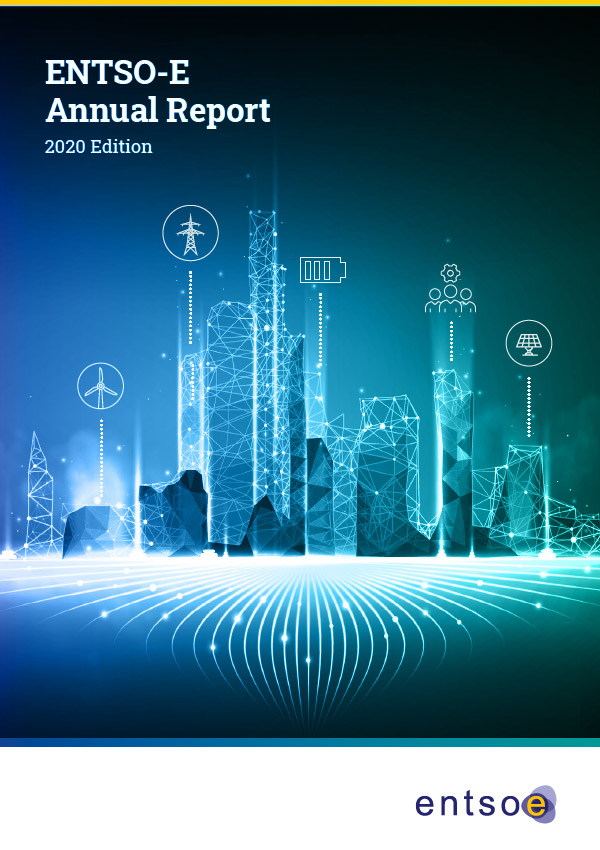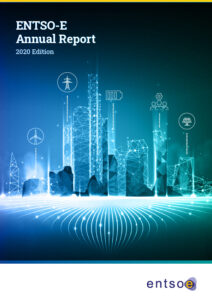1 System Operation
| Further SOGL deliverables in 2020 | Key documents and dates | ||
|---|---|---|---|
| Art. 75.1: | Methodology for coordinating operational security analysis | 18 Dec 2020: | amendment submitted to ACER |
| 13 Aug – 23 Sep 2020: | public consultation | ||
| Art. 76.1: | Core TSOs’ common provisions for regional operational security coordination | 4 Dec 2020: | ACER approval (ACER approved the Proposal subject to the amendments set out in Annex I to Decision 33/2020.) |
| Art. 76.1: | Hansa TSOs’ common provisions for regional operational security coordination | 18 Oct 2020: | amendment submitted to relevant NRAs (As per the Hansa NRAs request of 20 July 2020. The initial Proposal was submitted on 20 December 2019.) |
| Art. 76.1: | SEE TSOs’ common provisions for regional operational security coordination | 4 Dec 2020: | ACER approval (ACER approved the Proposal subject to the amendments set out in Annex I to Decision 34/2020.) |
| Art. 156.11: | CBA for suggesting the required minimum activation time for FCR in the Continental Europe and Nordic synchronous areas | 29 May 2020: | Submission to relevant NRAs (The submission date refers to Nordic NRAs. Submission to Continental Europe NRAs is due for October 2021.) |
| 27 Feb – 30 Apr 2020: | public consultation | ||
| Art. 137.3-4: | Nordic TSOs’ proposal for ramping restrictions for active power output | 3 Aug – 4 Sep 2020: | public consultation (Nordic TSOs submitted the proposal to the relevant NRAs in March 2021, which will in turn make a decision by October 2021. These developments are outside the scope of this Report and will be covered in the Annual Report 2021, to be drafted next year.) |
Table 1 – SO GL implementation activities in 2020
Implementation monitoring
Between July and September 2020, ENTSO-E released three important yearly implementation monitoring reports: the Incident Classification Scale annual report (Art. 15 SOGL), the annual report on Load-Frequency Control (Art. 16 SOGL) and the all TSOs’ scenario definition and scenario description for the year 2020 (Art. 65 SOGL).
In December 2020, ENTSO-E organised a workshop to discuss the current implementation status of the Key Organisational Requirements, Roles and Responsibilities (KORRR) with its stakeholders. The proposal was developed in 2018 in accordance with SOGL Article 40(6).
Key dates & documents
15 July 2020: Publication of the All TSOs’ scenario definition and scenario description for the year 2021
30 Sep 2020: Publication of the Incident Classification Scale 2019 annual report
30 Sep 2020: Publication of the Load-Frequency Control annual report
11 Dec 2020: Stakeholder Workshop on the National Implementation of KORRR
The Emergency and Restoration Code
The Emergency and Restoration Network Code (NC ER) sets out harmonised rules on how to deal with emergency situations and restore the system as efficiently and as quickly as possible. It entered into force on 18 December 2017 and is primarily subject to implementation at a national or TSO level. Implementation should be finished by December 2022 (Art. 55 NC ER).
ENTSO-E has monitored the national implementation of the network code (Art. 52.1 NC ER). In December 2020, it also delivered an assessment of the level of harmonisation of the rules for the suspension and restoration of market activities established by TSOs (Art. 36.7 and 52.1 NC ER).
The implementation of the NC ER was discussed with stakeholders during meetings of the System Operation European Stakeholder Committee that took place in 2020.
Key dates & documents
25 March 2020: Public webinar discussing the Report for assessing the level of harmonisation of the rules for suspension and restoration of the market activities
18 December 2020: Submission to ACER of the Report Assessing the Level of Harmonisation of the Rules for Suspension and Restoration of Market Activities
Common Grid Models
The legal basis for CGMs is found in three of the Network Codes: the SOGL (Art. 64), the Capacity Allocation and Congestion Management (CACM) Regulation (Art. 17) and the Forward Capacity Allocation (FCA) Regulation (Art. 18). The CGM Build Process and its data exchange system, the Operational Planning Data Environment (OPDE), are a prerequisite for several services harmonised in the Network Codes, including coordinated capacity calculation, operational security analysis, outage planning coordination and adequacy analysis.
A CGM compiles the Individual Grid Model (IGM) of each TSO, covering timeframes from one year before real time to one hour before real time. TSOs’ IGMs, after following a quality assessment and pan-European alignment process, are picked up by Regional Security Coordinators (RSCs), who merge them into a pan-European CGM and feed the merged CGM back into the system.
Achievements and Challenges
The CGM Programme is mandated to establish the CGM Build Process among ENTSO-E, TSOs and RSCs based on the Physical Communication Network (PCN) and the OPDE. During 2020, the CGM Programme delivered several critical milestones including:
- The connection of 67% of TSOs to the PCN. PCN is a pan-European physical network for inter-TSO/RSC communications, designed for real-time and non-real-time data exchange. The PCN network is intended to be a single physical network for OPDE and associated services (e.g. CGM Build Process, balancing platforms).
- Two upgrades of the ENTSO-E’s Connectivity and Communication Service Platform (ECCoSP), a software component that enables standardised, secure and reliable data exchange among different parties (e.g. TSOs, RSCs).
- Testing of the CGM Build Process with ENTSO-E, TSOs and RSCs
- Drafting of a set of requirements that will enable smooth processing by a third party, allowing interoperability between tools on a pan-European scale.
Operational Planning Data Environment
The OPDE, specified in the SOGL (Art. 114), is the information platform that will support the data exchange and business processes associated with the CGM Build Process. It is also the foundation of the data exchange platform for fulfilling the five core tasks of RSCs.
In 2020, two releases of the OPDE Platform, including the connection of new applications and the evolution of existing applications, were published. Moreover, the already existing part of the OPDE was operated and maintained throughout 2020.
ENTSO-E Awareness System
The EAS provides a real-time pan-European view of the state of transmission systems. All operators input a number of measurements including frequency and cross-border exchange. These measurements are then merged to provide an overall European view of each TSO on the platform. ENTSO-E has been monitoring the maintenance of the EAS to ensure its continuous operations within TSO business Service-Level Agreements (SLAs).
The following evolutions were introduced during 2020: automatic TSO online data quality check and improvement in the generation map. Moreover, technical upgrade and sandbox management were also performed.
Regional development
Cooperation at the regional level is a building block for ensuring security of supply and implementing the internal energy market. The development of variable generation and increased interconnections render regional coordination among TSOs more important than ever.
ENTSO-E supports regional tasks where it is beneficial for the TSOs of the region. In this respect, ENTSO-E provides a platform for coordinating regional deliverables which affect neighbouring regions and where addressing the matter at the pan-European level is more efficient than doing so bilaterally.
Regional Coordination
RSCs are entities owned and appointed by TSOs to fulfil five tasks: security analysis, capacity calculation, outage coordination, adequacy forecast, and the CGM creation. The System Operation Guideline formalised the role of the RSCs and made it legally binding for TSOs to procure at least the five core tasks from one of the RSCs. Through their recommendations to TSOs, RSCs contribute to increasing efficiency in system operation; minimising the risks of wide-area events such as brownouts or blackouts; and lowering costs through ensuring the maximised availability of transmission capacity to market participants.
Key dates & documents
22 May 2020: Establishment of SEleNe CC
1 Oct 2020: Submission to ACER of the Capacity Calculation Regions Assessment Report
In May 2020, the four TSOs – ESO-EAD (Bulgaria), IPTO (Greece), Transelectrica (Romania) and Terna (Italy) – of the South-East Europe (SEE) and Greece–Italy (GRIT) capacity calculation regions (CCRs) established the Southeast Electricity Network Coordination Centre (SEleNe CC), located in Thessaloniki.
In October 2020, ENTSO-E submitted on behalf of all TSOs the Capacity Calculation Regions Assessment Report. This report addresses the ACER Decision 04/2019 on the Amendment of the determination of CCRs of 1 April 2019. According to the amendment, the TSOs shall analyse the optimal determination of CCRs with regard to Hansa and Channel CCRs. This report concludes that the current structure of the CCR Hansa and CCR Channel are the most optimal structure for ensuring progress in the current implementation of the flow-based methodologies and other regional methodologies in CCR Core and CCR Nordic in the short-term.
Regional Security Coordinators and the Clean Energy Package
The CEP establishes an enhanced framework for regional cooperation through the establishment of Regional Coordination Centres (RCCs). Art. 35 of Regulation (EU) 2019/943 (the “Electricity Regulation”) requires that TSOs of System Operation Regions (SORs) develop a proposal for the establishment of the RCCs of their region. These should be operational by 1 July 2022 and will replace existing RSCs, adding new tasks for the RCCs1.
ENTSO-E developed and submitted in January 2020 a proposal defining SORs in compliance with Art. 36 of the Electricity Regulation. The SOR Proposal specifies that some of the new tasks shall be carried out through a SOR configuration, and others through CCR or other configurations. ACER amended the proposal in April 2020, and it was appealed by ENTSO-E in June 2020. In October 2020, the ACER Board of Appeal asked the Agency to issue a new decision.
1 Article 37 of the Electricity Regulation mentions 10 new tasks in addition to the ones provided for by SOGL and the NC ER as adopted on the basis of Regulation 714/2009.
Other regional developments
ENTSO-E launched the pan-European IT tools for OPC and STA, aimed at increasing the operational security of Europe’s power system. The OPC, live since end of March 2020, allows RSCs and 38 TSOs to coordinate outage planning on a weekly basis. Based on generation and demand forecast provided by all ENTSO-E Member TSOs, the STA, launched in May 2020, enables RSCs and TSOs to perform daily calculations which identify any possible lack of adequacy for the week ahead. ENTSO-E and the Baltic RSC co-organised the RSC Conference held in a digital format in November 2020. The event took stock of the latest trends and discussed how innovation, data and digitalisation, regulatory framework, TSO cooperation, and offshore support regional development in the power sector.
Key dates & documents
24 November 2020: RSC Conference 2020
Future synchronisation of Baltic countries to the Continental Europe synchronous area
In 2020, the Baltic TSOs continued work on the implementation of technical measures specified in the “Agreement on the Conditions for a Future Synchronous Interconnection of the power system of the Baltic States and the power system of Continental Europe”, which entered into force on 27 May 2019.
They focused on creating the infrastructure and tools to enable frequency and dynamic stability as foreseen in the studies performed in 2018 and further detailed in 2019 and 2020 in related projects.
The Baltic synchronisation with Continental Europe is part of the EU Energy Union strategy and will enable the Baltic TSOs to operate their systems under the EU rules.
The vast majority of the System Operation tasks aim to improve operations and secure electricity supply by enhancing forecast, planning and regional coordination to cope with higher and higher volumes of variable RES and with the gradual phase out of conventional power plant in the system. This is key to achieving a carbon-neutral European energy system by 2050.
Download
ENTSO-E Annual Report 2020
This Annual Report covers the period from January to December 2020. It focuses on the legal mandates given to ENTSO-E. The activities covered in this report were performed thanks to the 42 members of ENTSO-E who provide its financial resources and whose staff provides expertise to the Association.
Chapters:
- System Operation
- Market
- System Development
- Transparency Regulation
- Research, Development and Innovation
- Cybersecurity, Interoperability and Data
- TSO–DSO partnership and demand side flexibility






